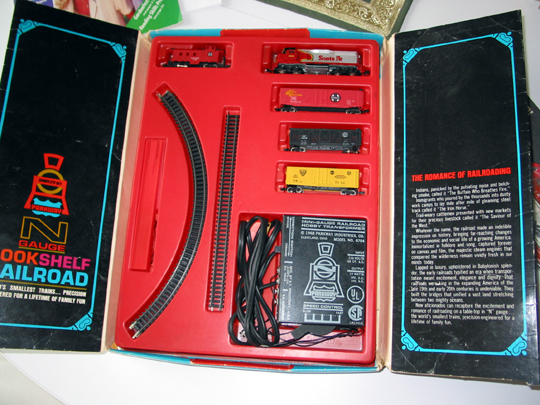GP40 -

GP38-2 -

GP40 -

GP38-2 -

Introduced: 1968 (first GP40), 1969 (revised GP40), 1987 (split-frame GP40), 2018 (DCC-Friendly GP40), 2019 (DCC-Sound GP40), and 2021 (DCC-Sound GP38-2)
Like the rest of Bachmann's cheapie "Trainset Style" line of locomotives, their GP40 has been around forever and undergone numerous facelifts over the years. As far as I know (based on purchasing more of them off of eBay than anyone should ever have to), there have been three basic shell designs and five basic mechanism designs (six if you count the "dummy" version).
The earliest version is easily identified by its laughably oversized shell, absolutely gigantic motor, and all white-metal frame. Another identifying feature of these models are the words "Bachmann" and "Hong Kong" stamped on the bottom of the fuel tank.


This first version is loud (brass gears), it's wobbly, and my lord, it's ugly. And for whatever reason, these are really hard to find nowadays with both the end handrails intact. I don't know if they were particularly susceptible to breaking and/or falling off, or if it's just the effects of old age. But whatever the case, it's quite a chore to find one that still has both of them. The same thing can be said for the horn, although "missing horn syndrome" is a malady common to pretty much all old locomotive models.
Dummy units were available up until about 1975, but as far as I know they all employed this same first-generation oversized shell. Also (and inexplicably), ala carte first-generation shells were manufactured by someone and sold in blister packs on eBay as recently as 2013.
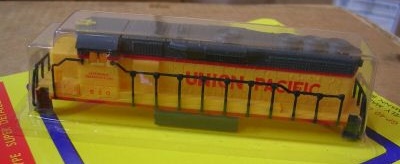
The second design features a much smaller shell and a much improved mechanism. The frame is stamped "Bachmann" and "Hong Kong" on the bottom of the fuel tank and consists of a combination of white and black metal. Performance isn't horrible, but it still sports noisy metal gears. And yes, it does have lights on both the front and back now, but they are not directional (IE, both are lit whenever current is present). So OK, not the worst locomotive model I've ever encountered, but definitely and firmly stuck in the "toyish" category.

Bachmann's GP40 received a new and improved mechanism in 1987 (no shell changes, though).
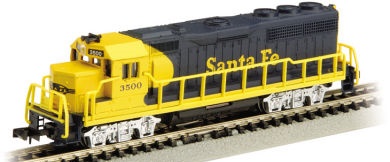
The mechanism was actually designed for Bachmann's new GP50, but was also used to repower their GP40 and U36B models. The first version was stamped "Bachmann" and "Hong Kong" on the sides of the fuel tank. The mechanism (now all black metal) sports a split-frame chassis, 3-pole skew-wound motor and all-plastic gearing. A slightly revised version came out shortly after the initial 1987 release. This one is stamped "Bachmann" and "China" (or "Made in China") on the fuel tank and has some angular jogs in the seams along the top of the chassis -
The above "white box" versions have white plastic gears and two little sticky-uppy prongs on the front of the chassis. The more recent "jewel box" versions have black plastic gears and no prongs. And although it's hard to tell, the motors may have changed somewhere along the line as well (the motors on the more recent releases look to be just a titch smaller) -

These third generation models are acceptable runners (and definitely superior to either of the earlier versions) - good pickup, smooth control, and decent slow speed performance. But let's face it, they're still firmly stuck in the "trainset toy" category (what with the open pilots, truck-mounted couplers, and lights shining through the shells). Couplers vary depending on how recently a given model was made (transitioning from Rapido-style couplers, to one-piece knuckle couplers, to Bachmann's "E-Z Mate" automatic/magnetic knuckle couplers).

As pictured at the top of the page, Bachmann released a completely revised GP40 in 2018. The chassis is all metal and split-frame. The main PC board is screwed to metal posts on top of the chassis (from which it receives chassis current). Wires from the main PC board transfer current to the motor and to small LED boards slotted into the front and back of the chassis (for the headlight and backup light). The LEDs provide bright white lighting. The lighting is directional insofar as the headlight is brighter than the backup light when moving forward. When backing up, the headlight dims a little and the backup light gets a little brighter. The main PC board has six contacts labeled for track power, motor control, headlight and backup light, so I suppose you could call these models "DCC Ready" (or at least "DCC Friendly"). However, they were never released with factory-installed decoders (not with this board anyway). Also, Bachmann doesn't provide any instructions for decoder installation (or even claim that they're DCC Ready), so you're pretty much on your own there.

The motor is a round can (presumably coreless) equipped with a single/small flywheel. The multi-piece plastic driveshafts spin worms which seat between brass bearing blocks mounted to plastic brackets that clip inside the chassis.
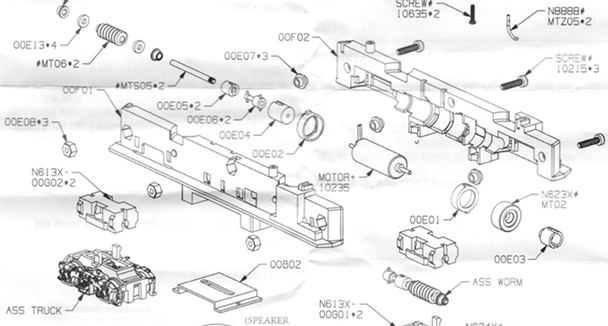
All four axles are geared. Apart from the brass worms all of the gearing is black plastic. The wheels are blackened and all eight of them provide pickup (no traction tires). The wheels are low profile (no problems on Atlas C55 rails). The separate plastic fuel tank detail has speaker holes -

Pickup is provided by wheelback wipers which have flimsy/bendy contacts that brush up against burnished spots on the underside of the chassis. The trucks clip inside the worm brackets and pop out with minimal effort.
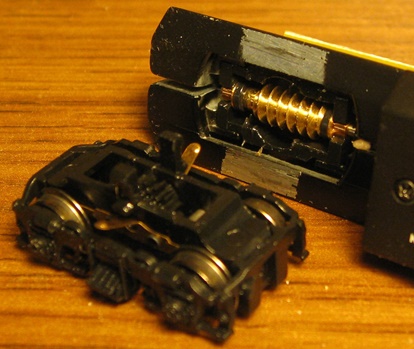
The couplers are shell-mounted E-Z Mates (ala carte Rapido-style replacement couplers are included in the box for those wishing to go down that road). Note that although there are numberboard inserts, they do not light up. The shell is held to the chassis by simple friction and slides up and off with minimal effort. Note that this new shell doesn't fit any of the earlier (larger) chassis designs.

Looks-wise, these models compare quite favorably with the Atlas GP40. In fact, if it weren't for the E-Z Mate couplers, I would be hard-pressed to tell which was which (DME=Atlas, MKT=Bachmann) -

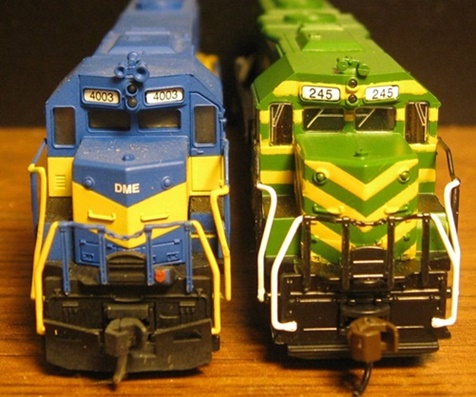
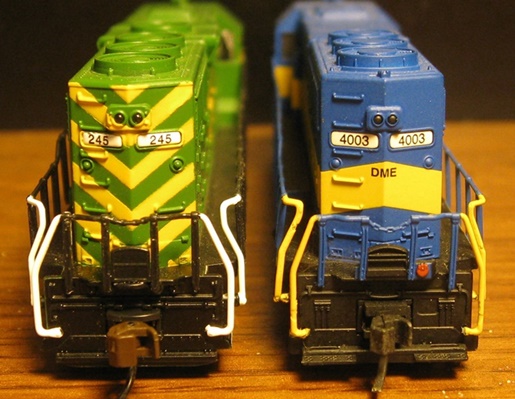
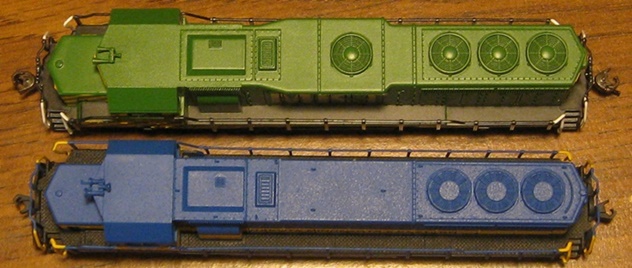
Performance on this version is outstanding in pretty much every way. It runs whisper quiet and smooth as butter at all throttle settings. Slow speed creep is one-tie-at-a-time. As for the top-end speed, I initially thought that it was going to be quite low (like yard switcher low), but after a bit of break-in time it turned out to be quite the sprinter at the high end of the throttle (for those who worry about such things). Despite the (IMHO) suboptimal pickup situation, I didn't have any problems creeping mine through insulted-frog turnouts at yard speeds. Also no problems with any of the wheels derailing on sharp (9.75" radius) curves. Pulling power actually exceeds that of my Atlas GP40, with mine able to handle around 23 assorted 50' freight cars through curves on level track (any more than that and either the wheels are slipping or the trucks are derailing). Overall, these are very nifty little locos that are quite the bang for the buck (I purchased mine brand new for $40, which is about half what a DCC-Ready Atlas GP40 would cost me).
As noted above, Bachmann released DCC-Sound versions of their GP40 in 2019. Same basic internals as the 2018 release, but with an Econami Sound Value DCC-Sound decoder and speaker. The speaker is round and mounted inside the fuel tank (glued in actually, so I can't really photograph it).

These DCC-Sound models run every bit as nicely as the 2018 analog versions (and as a group, they may well be the best running Bachmann diesels to date). The sound is also quite impressive. Unfortunately, these are decidedly not much of a bargain ($279 MSRP and around $180 "on the street" - so right around what Atlas is charging for their DCC-Sound diesels).
As noted above, Bachmann released their first GP38-2 model in 2021. I haven't been able to acquire one yet, but my assumption that they share the same internals as the 2019 GP40 models.
The first GP40 (1968) came in a white and clear plastic box with the locomotive sitting upright and held in place with a screw. These same first generation models were also available in "Parkway Industries" packaging (some sort of Bachmann subsidiary). Same box, same models, different brand name. The second version came in a yellow and black plastic box (1969-1975) or a blue and white plastic box (1975-1983). The split-chassis version came in a white cardboard box (1987-2001) or a plastic jewel case (2001-present). The newest versions also come in a plastic jewel case (you can differentiate them from the previous version by the new/redesigned tank, which does not have slots for chassis clips on the sides).
These same models were also distributed by Tomy in the 1970s (probably only in Japan). Same packaging, but with the Tomy name added. EG -
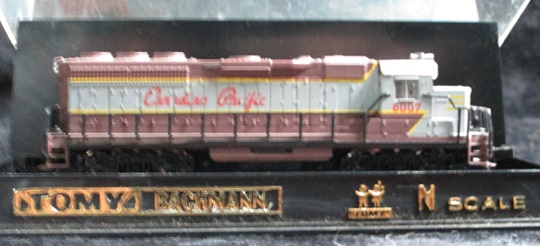
Grades: D for the first version, C for the middle versions, A for the DCC-Friendly and DCC-Sound versions
Reviewed: 9/69 Model Railroader (redesigned second version): ("The ready-to-run model closely follows the proportions and dimensions of the prototype. The overall height and width are slightly large- the hood, for instance, scales 7 feet wide instead of 6 feet. This was apparently necessary to provide sufficient room for the motor. The mounting of the railings is unorthodox. Under normal viewing these slight liberties are not noticeable... The painted and lettered model follows construction similar to that of most N scale diesel hood units. The superstructure is well-detailed polystyrene plastic molding. The ends of the unit have large openings to accommodate the truck-mounted Rapido-type couplers... The railings are plastic castings which appear too heavy... A small five-pole 12-volt DC motor mounted at the center of the frame drives all eight wheels on both trucks through a nickel-plated worm-and-gear-plus-spur-gear drive. All wheels are hub-insulated and are provided with electric wipers; thus all wheel sets provide for electrical pickup... The plastic sideframes are a good representation of an EMD four-wheel power truck. Wheels scale 48" in diameter as opposed to 40" on the prototype. This was probably done to accommodate a large gear on the axle. Flanges are .040" deep. Check gauge is .317"... Smooth starting is fair, but control is good through all upper speed ranges.. Correct operating speeds are obtained only with lower voltages... This is a fine-running model, well detailed, with good lettering... Available in Penn Central, Burlington, Great Northern, Union Pacific, Reading and Santa Fe... Prices: $14.98 (powered) and $5.98 (dummy)")
Here's one of those old bookshelf trainsets with a GP40 lurking inside:
